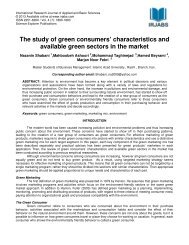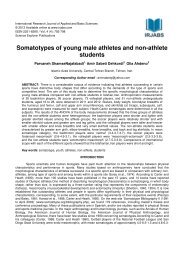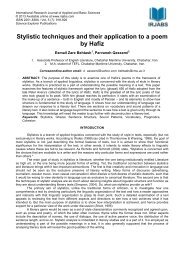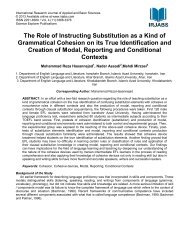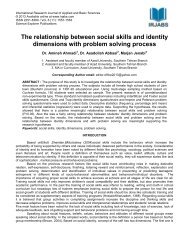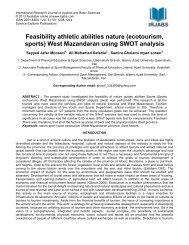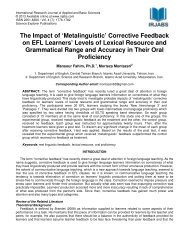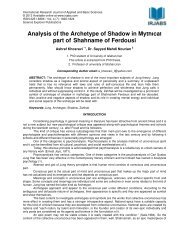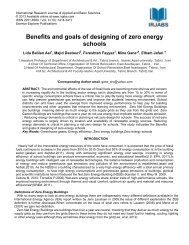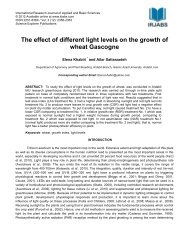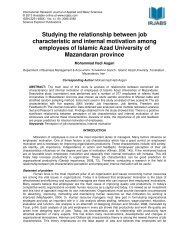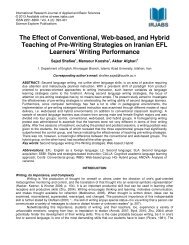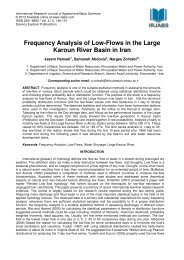Anti-Islanding Protection Using Histogram Analysis in Self Excited ...
Anti-Islanding Protection Using Histogram Analysis in Self Excited ...
Anti-Islanding Protection Using Histogram Analysis in Self Excited ...
Create successful ePaper yourself
Turn your PDF publications into a flip-book with our unique Google optimized e-Paper software.
International Research Journal of Applied and Basic Sciences<br />
© 2013 Available onl<strong>in</strong>e at www.irjabs.com<br />
ISSN 2251-838X / Vol, 4 (10): 2897-2907<br />
Science Explorer Publications<br />
<strong>Anti</strong>-<strong>Island<strong>in</strong>g</strong> <strong>Protection</strong> <strong>Us<strong>in</strong>g</strong> <strong>Histogram</strong> <strong>Analysis</strong><br />
<strong>in</strong> <strong>Self</strong> <strong>Excited</strong> Generations W<strong>in</strong>d Turb<strong>in</strong>es<br />
Mehdi Nooshyar 1 , Behrooz Sobhani *1<br />
1. Technical Eng<strong>in</strong>eer<strong>in</strong>g Department, University of Mohaghegh Ardabili, Ardabil, Iran<br />
∗ Correspond<strong>in</strong>g author email :b.sobhany@gmail.com<br />
ABSTRACT: Increas<strong>in</strong>g distributed resources create many problems <strong>in</strong> power systems. One of these<br />
problems is unwanted island<strong>in</strong>g phenomenon. Due to several reasons concern<strong>in</strong>g such as personnel and<br />
equipment safety, this condition should be detect <strong>in</strong> the fastest possible time. This paper is proposed a<br />
novel passive island<strong>in</strong>g detection algorithm based on voltage histogram analysis for w<strong>in</strong>d turb<strong>in</strong>es. The<br />
proposed method measures the voltage signal of w<strong>in</strong>d turb<strong>in</strong>e and detects island<strong>in</strong>g condition based on<br />
its mean square error. In order to reliable and fast detection, the sampl<strong>in</strong>g w<strong>in</strong>dow is selected from<br />
system time constant <strong>in</strong> island<strong>in</strong>g mode. The presented studies are based on time-doma<strong>in</strong> simulations<br />
us<strong>in</strong>g MATLAB, The results evaluation confirm that the proposed island<strong>in</strong>g detection method succeeds <strong>in</strong><br />
detect<strong>in</strong>g island<strong>in</strong>g mode from other switch<strong>in</strong>g conditions. Other contributed of proposed method is nondetection<br />
zone reduction of the system and also the reliability and fastness of detection process is<br />
<strong>in</strong>creased.<br />
Keywords: <strong>Island<strong>in</strong>g</strong> Detection, W<strong>in</strong>d Turb<strong>in</strong>e, <strong>Histogram</strong> algorithm, Distributed Generation, MSE<br />
INTRODUCTION<br />
DGs generally refer to Distributed Energy Resources (DERs), <strong>in</strong>clud<strong>in</strong>g photovoltaic, fuel cells, micro turb<strong>in</strong>es,<br />
small w<strong>in</strong>d turb<strong>in</strong>es, and additional equipment. In recent years, the <strong>in</strong>crease of distributed resources <strong>in</strong> the electric<br />
utility systems with ongo<strong>in</strong>g technological, social, economical and environmental aspects shows high depth of<br />
penetration of Distributed Generations (DGs). With improv<strong>in</strong>g <strong>in</strong> DGs technologies and power electronics, DG units<br />
have become more competitive aga<strong>in</strong>st the conventional centralized system. Hence, it attracts many customers<br />
from <strong>in</strong>dustrial, commercial, and residential sectors (Ze<strong>in</strong>eld<strong>in</strong> et al., 2006; Chiang et al., 2012; Jiayi et al., 2008)<br />
Many utilities around the world already have significant penetration of DGs <strong>in</strong> their system. Annually, the total<br />
global <strong>in</strong>stalled w<strong>in</strong>d capacity at the end of 2010 was 2.5% of the total global demand. Based on the current growth<br />
rates, World Wide Energy Association (WWEA) predicts that, <strong>in</strong> end of the year 2020, at least 1500 GW can be<br />
expected to be <strong>in</strong>stalled globally (www.renewableenergyworld.com). When the distributed generation systems are<br />
operated <strong>in</strong> parallel with utility power systems, especially with reverse power flow, the power quality problems<br />
become significant. Power quality problems <strong>in</strong>clude frequency deviation, voltage fluctuation, harmonics and<br />
reliability of the power system. In addition, one of the technical issues created by DG <strong>in</strong>terconnection is <strong>in</strong>advertent<br />
island<strong>in</strong>g (Dash et al., 2012; Ze<strong>in</strong>eld<strong>in</strong> et al., 2006). <strong>Island<strong>in</strong>g</strong> occurs when a DG and its local load become<br />
electrically isolated from the utility; meanwhile, the DG produces electrical energy and supplies the local load<br />
(Jayaweera et al., 2007). <strong>Island<strong>in</strong>g</strong> condition causes abnormal operation <strong>in</strong> the power system and also causes<br />
negative impacts on protection, operation, and management of distribution systems. Therefore, it is necessary to<br />
effectively detect the island<strong>in</strong>g conditions and swiftly disconnect DG from the network. Exist<strong>in</strong>g standard thus do<br />
not permit DGs to be utilized <strong>in</strong> island<strong>in</strong>g mode (Ze<strong>in</strong>eld<strong>in</strong> et al., 2007) because <strong>Island<strong>in</strong>g</strong> creates many problems<br />
(Ze<strong>in</strong>eld<strong>in</strong> et al., 2007; Swisher et al., 2001) <strong>in</strong> power systems such as: Safety hazards for personnel, Power quality<br />
problems for customers load, overload conditions of DG, out-of-phase recloser connections. In order to avoid the<br />
above problems occurr<strong>in</strong>g, island<strong>in</strong>g conditions should be detected with<strong>in</strong> less than 2 s (Wilsun et al., 2004).<br />
Orig<strong>in</strong>ally, the methods of island<strong>in</strong>g detection were divided <strong>in</strong>to two categories: communication and local. Local<br />
methods were classified as active and passive techniques, <strong>in</strong> which active techniques are based on direct<br />
<strong>in</strong>teraction with the ongo<strong>in</strong>g power system operation (Ze<strong>in</strong>eld<strong>in</strong> et al., 2007). Some important active techniques are<br />
impedance measurement, frequency shift and active frequency drift (Chowdhury et al., 2009), current <strong>in</strong>jection
Intl. Res. J. Appl. Basic. Sci. Vol., 4 (10), 2897-2907, 2013<br />
(González and Iravani., 2006), Sandia frequency shift and Sandia voltage shift (John and Kolwalkar., 2004), and<br />
negative phase sequence current <strong>in</strong>jection (Karimi et al., 2008). Active methods usually used <strong>in</strong> converter based<br />
distributed generator. Passive techniques that used <strong>in</strong> <strong>in</strong>duction w<strong>in</strong>d turb<strong>in</strong>e generator are based on<br />
measurements and <strong>in</strong>formation at the local site. Over/under voltage and frequency (Kazemi and Sobhani., 2012) is<br />
one of the simplest passive methods used <strong>in</strong> island<strong>in</strong>g detection. Unfortunately, if the load and the generation on<br />
the island are closely matched, the change <strong>in</strong> voltage and frequency might be very small and with<strong>in</strong> the thresholds,<br />
thus lead<strong>in</strong>g to an undetected island<strong>in</strong>g situation. Other passive techniques have been proposed based on<br />
monitor<strong>in</strong>g rate of change of frequency (ROCOF)(El-Arroudi et al., 2007) and Rate of change of phase angle drift<br />
(ROCOPAD), phase angle displacement, rate of change of generator power output (Chowdhury et al.,2009),<br />
impedance monitor<strong>in</strong>g, the THD technique, non detection zone concept (Zhihong et al.,2004), vector surge and<br />
phase displacement monitor<strong>in</strong>g (Kunte and Gao .,2008) and the wavelet transform function (Hsieh et al., 2008).<br />
This paper <strong>in</strong>troduces a novel approach for island<strong>in</strong>g detect<strong>in</strong>g based on voltage histogram signal that reduce<br />
the NDZ. High distortion <strong>in</strong> voltage signal measurement is caused the Mean Absolute Error (MAE) of island<strong>in</strong>g<br />
mode voltage become very higher than grid connected mode. In order to detect island<strong>in</strong>g condition of w<strong>in</strong>d<br />
turb<strong>in</strong>es, we use of this MAE signal of voltage <strong>in</strong> this paper. The results <strong>in</strong> several conditions of local loads can be<br />
prov<strong>in</strong>g this pretense and illustrate its robust performance for island<strong>in</strong>g detection. This approach measures the<br />
voltage signal at the target distributed generation location and feeds it to the proposed histogram based algorithm<br />
<strong>in</strong> order to detect the island<strong>in</strong>g condition from other conditions.<br />
The proposed technique, which is suitable for asynchronous DGs, is expla<strong>in</strong>ed <strong>in</strong> Section 2. In Section 3 the<br />
simulation test system that used to verify the effectiveness of the proposed method is present. Section 4 explores<br />
the mathematical model and Non-Detection Zones concepts. Effectiveness and robustness of the proposed<br />
algorithm applied to the simulation test systems is present <strong>in</strong> section 5 and Section 6 concludes the paper. The<br />
simulation test systems were simulated <strong>in</strong> MATLAB/SIMULINK. The simulation results show that the proposed<br />
island<strong>in</strong>g detection technique can successfully detect island<strong>in</strong>g operations with<strong>in</strong> acceptable time duration.<br />
Proposed Algorithm<br />
Normalized <strong>Histogram</strong><br />
Let { 0,1,2,...,<br />
M −1}<br />
denote the M dist<strong>in</strong>ct values <strong>in</strong> a discrete signal of size N samples, and let n i denote the<br />
number of samples with value i. The total number, N, of samples is N = n0 + n1<br />
+ ... + nM<br />
−1<br />
. The normalized<br />
ni<br />
histogram has components (samples) pi = , from which it follows that:<br />
N<br />
M<br />
− 1<br />
p i = 1<br />
(1)<br />
i=<br />
0<br />
Inter <strong>Histogram</strong> Mean Square Error (IHMSE)<br />
We <strong>in</strong>troduce a measure for calculat<strong>in</strong>g the difference between two histograms and call it Inter <strong>Histogram</strong> Mean<br />
Square Error (IHMSE). Consider two histograms H 1 and H 2 . If the total number of dist<strong>in</strong>ct values (M) for two<br />
histograms are the same and ph ji shows the ith normalized component (i=1,2 …,M) of jth (j=1,2) histogram, the<br />
IHMSE between H1 and H2 is calculated as follows:<br />
1 K<br />
− 1<br />
2<br />
IHMSE ( H 1,<br />
H 2 ) = ( n i 1 − n i 2 )<br />
(2)<br />
K i = 0<br />
For each possible pairs of the histograms of island<strong>in</strong>g cases the IHMSE values are calculated and reported.<br />
Similarly for each possible pairs of the histograms of non-island<strong>in</strong>g cases the IHMSE values are calculated and<br />
reported. These IHMSE values are called Auto IHMSE (AIHMSE) because they represent difference between two<br />
histograms which related to the similar conditions. An IHMSE value, which is calculated between an island<strong>in</strong>g case<br />
histogram and a non-island<strong>in</strong>g case histogram, is called Cross IHMSE (CIHMSE) (Nobuyuki Otsu.,1979).<br />
The average value of CIHMSE is greater than the average value of AIHMSE. This difference between CIHMSE<br />
and AIHMSE values is motivated us to <strong>in</strong>troduce an approach to classify an unknown condition, based on the<br />
calculation of IHMSE (between it and known island<strong>in</strong>g or non-island<strong>in</strong>g cases), <strong>in</strong>to island<strong>in</strong>g cases or nonisland<strong>in</strong>g<br />
cases.<br />
2898
Intl. Res. J. Appl. Basic. Sci. Vol., 4 (10), 2897-2907, 2013<br />
Suppose that we have NI known island<strong>in</strong>g cases and NN known non-island<strong>in</strong>g cases, These cases are the<br />
tra<strong>in</strong><strong>in</strong>g cases of the proposed method, then we can calculate (NI 2 + NN 2 ) and (NI×NN) possible AIHMSE and<br />
CIHMSE values respectively. All of the AIHMSE and CIHMSE values (The number of them is: NI 2 + NN 2 + NI×NN)<br />
are sorted and the histogram of them is considered. This histogram is called IHMSE histogram. It is expected that<br />
the IHMSE histogram will be a bipartite histogram <strong>in</strong> which the CIHMSE values are placed <strong>in</strong> one part and the<br />
AIHMSE values are placed <strong>in</strong> another part. Thus, a proper threshold value, we call it k*, separate the IHMSE<br />
histogram <strong>in</strong>to two groups.<br />
The value of k* can be found by an appropriate threshold<strong>in</strong>g method such as Otsu method (Nobuyuki<br />
Otsu.,1979). For an unknown case if its voltage histogram is accessible, the IHMSE values between it and known<br />
island<strong>in</strong>g cases are calculated. The average value of these IHMSEs is called as k 1 . Similarly the IHMSE values<br />
between it and known non-island<strong>in</strong>g cases are calculated and the average value of these IHMSEs is called as k 2 .<br />
By Compar<strong>in</strong>g of the value of k* with k 1 and k 2 we can determ<strong>in</strong>e the condition of the unknown case.<br />
Case Study<br />
S<strong>in</strong>gle l<strong>in</strong>e diagram of study system <strong>in</strong> this research, is shown <strong>in</strong> Fig 1. The DG unit is a w<strong>in</strong>d turb<strong>in</strong>e <strong>in</strong>duction<br />
generator which its rated voltage is 0.69 kV and is connected to a Po<strong>in</strong>t of Common Coupl<strong>in</strong>g (PCC) with a step-up<br />
transformer that its rated power is 1.5MVA. The local load is a three-phase parallel RL before the circuit breaker<br />
(CB), <strong>in</strong> which “r” stands for the series resistance <strong>in</strong>ductance and R L is the parallel load that connected to system <strong>in</strong><br />
Y connection. In order to correction the power factor a capacitor bank is used. Local load and system parameters<br />
are given <strong>in</strong> Table 1. In the grid-connected condition, the island<strong>in</strong>g mode occurs when SW2 is open. For the<br />
evaluation of island<strong>in</strong>g detection techniques the parallel R L is traditionally adopted as the local load when the load<br />
<strong>in</strong>ductance is adjusted to the system frequency. The amount of local load and capacitor should be set to allowable<br />
amount, that <strong>in</strong> island<strong>in</strong>g condition the voltage, current and frequency rema<strong>in</strong> <strong>in</strong> allowable value.<br />
It should be noted that the frequency and voltage of DG should have admissible values <strong>in</strong> both grid-connected<br />
and islanded modes. In the grid-connected condition, the voltage magnitude and frequency of the local load at the<br />
PCC are regulated by the grid.<br />
Figure 1. S<strong>in</strong>gle l<strong>in</strong>e diagram of study system<br />
Table1. Parameters of test system<br />
DG nom<strong>in</strong>al power<br />
660KVA<br />
Voltage rms (L-L)<br />
0.69kV<br />
r s 0.5269<br />
L s<br />
17.1mH<br />
Nom<strong>in</strong>al freguency<br />
50HZ<br />
R<br />
2667<br />
L 2.37H<br />
C<br />
1.592F<br />
2899
Intl. Res. J. Appl. Basic. Sci. Vol., 4 (10), 2897-2907, 2013<br />
Mathematical Model<br />
System model<strong>in</strong>g<br />
State-space mathematical model for the islanded system have been provide <strong>in</strong> this section. In the island<strong>in</strong>g<br />
mode, the circuit model of w<strong>in</strong>d turb<strong>in</strong>e with fixed w<strong>in</strong>d speed has shown <strong>in</strong> Fig .2 a. and the simple model shown <strong>in</strong><br />
Fig .2 b. It is assumed that the DG unit and the local load are balanced three-phase subsystems with<strong>in</strong> the island.<br />
The state space equations of the potential island of Fig. 2 <strong>in</strong> the standard state space form are<br />
.<br />
X ( t)<br />
=<br />
y(<br />
t)<br />
= CX ( t)<br />
u ( t)<br />
=<br />
AX ( t)<br />
+ Bu ( t)<br />
v td<br />
In balanced three-phase subsystems with<strong>in</strong> the island, the state-space model is:<br />
<br />
abc<br />
di ( t)<br />
abc<br />
g<br />
abc abc<br />
v<br />
g ( t)<br />
= Ls<br />
+ rsi<br />
g ( t)<br />
+ vt<br />
( t)<br />
<br />
dt<br />
<br />
abc<br />
abc abc dvt<br />
( t)<br />
1 abc<br />
i<br />
g ( t)<br />
= im<br />
( t)<br />
+ C + vt<br />
( t)<br />
<br />
dt RL<br />
<br />
abc<br />
( t)<br />
<br />
abc dim<br />
abc<br />
vt<br />
( t)<br />
= Lm<br />
+ rmim<br />
( t)<br />
<br />
dt<br />
(3)<br />
(4)<br />
r s<br />
L ls<br />
L ' lr<br />
R L<br />
L<br />
r<br />
C<br />
L m<br />
R r<br />
s<br />
+<br />
V t R L<br />
−<br />
i L<br />
L m<br />
r m<br />
i m<br />
i c<br />
C<br />
r s<br />
L s<br />
i g<br />
V g<br />
Figure 2. Model of case study a) orig<strong>in</strong>al model b) simple model<br />
<br />
v<br />
<br />
<br />
ig<br />
<br />
<br />
vt<br />
<br />
In the αβ -frame, dynamic model of system is<br />
αβ<br />
g<br />
αβ<br />
αβ<br />
( t)<br />
( t)<br />
=<br />
( t)<br />
=<br />
αβ<br />
m<br />
m<br />
αβ<br />
g<br />
di<br />
= Ls<br />
dt<br />
i<br />
L<br />
( t)<br />
+ C<br />
αβ<br />
m<br />
di<br />
dt<br />
( t)<br />
( t)<br />
+ r i<br />
αβ<br />
t<br />
dv<br />
dt<br />
αβ<br />
s g<br />
( t)<br />
αβ<br />
m m<br />
+ r i<br />
( t)<br />
( t)<br />
+ v<br />
L<br />
αβ<br />
t<br />
1<br />
+ v<br />
R<br />
αβ<br />
t<br />
( t)<br />
( t)<br />
With transfer to rotat<strong>in</strong>g reference frame (<br />
condition and V t as reference frame:<br />
x<br />
αβ =<br />
x dq e<br />
(5)<br />
jθ<br />
) and assum<strong>in</strong>g of constant frequency <strong>in</strong> islanded<br />
2900
Intl. Res. J. Appl. Basic. Sci. Vol., 4 (10), 2897-2907, 2013<br />
di<br />
( t)<br />
gd 1 r<br />
= v ( t)<br />
− s i ( t)<br />
+ ωi<br />
( t)<br />
−<br />
dt L gd L gd gq<br />
s s<br />
<br />
di<br />
( t)<br />
gq<br />
1<br />
= −ωi<br />
( t)<br />
− ωi<br />
( t)<br />
+ v ( t)<br />
dt gd gd L tq<br />
s<br />
<br />
dv<br />
( t)<br />
td 1 1 1<br />
= i ( t)<br />
− i ( t)<br />
− v ( t)<br />
gd md td<br />
dt C C CR<br />
L<br />
<br />
<br />
di ( t)<br />
md 1<br />
rm<br />
= v t + ωi<br />
t − i t<br />
<br />
td ( ) mq ( ) md ( )<br />
dt L<br />
L<br />
<br />
m<br />
m<br />
di<br />
( t)<br />
r<br />
mq<br />
= −ωi<br />
( t)<br />
− m i ( t)<br />
dt md L mq<br />
<br />
m<br />
ωCv<br />
= i − i<br />
td gd mq<br />
1<br />
v<br />
L td<br />
s<br />
( t)<br />
F<strong>in</strong>ally the state-space equation can be written as follow:<br />
rs<br />
1 <br />
− ω0<br />
0 -<br />
• Ls<br />
L <br />
s<br />
igd<br />
<br />
<br />
r<br />
i<br />
m CRLω<br />
rs<br />
L <br />
0 − mω0<br />
i<br />
ω<br />
<br />
0 − − 2ω0<br />
gq<br />
L<br />
i<br />
<br />
m<br />
LmR<br />
<br />
=<br />
L<br />
i<br />
r<br />
<br />
md<br />
<br />
m 1 2 i<br />
<br />
0 ω0<br />
−<br />
− ω0C<br />
<br />
v<br />
L<br />
td <br />
m Lm<br />
<br />
<br />
1<br />
1 1 <br />
0 −<br />
<br />
C<br />
C CRL<br />
<br />
[ i i v v ] T<br />
gd<br />
gq<br />
td<br />
tq<br />
gd<br />
gq<br />
md<br />
v<br />
tq<br />
1<br />
<br />
<br />
L <br />
s<br />
<br />
<br />
+ 0<br />
<br />
<br />
0 <br />
<br />
<br />
0<br />
<br />
[ v ]<br />
x = (8)<br />
[ y] [ 0 0 1 0]x<br />
= (9)<br />
The transfer function of state-space model is given by<br />
−1<br />
Y ( s)<br />
= C.(<br />
SI − A)<br />
. B<br />
(10)<br />
( s) Y (s)<br />
V d = (11)<br />
2<br />
(1.5s + 15.63s<br />
+ 14790) e4<br />
V td ( s)<br />
= (12)<br />
4<br />
3<br />
2<br />
(4.0e<br />
− 4) s + 1.359s<br />
+ 1.542e4s<br />
+ 6.266e5s<br />
+ 1517e6<br />
The step response of output voltage is plotted <strong>in</strong> Fig. 3.<br />
gd<br />
(6)<br />
(7)<br />
2901
Intl. Res. J. Appl. Basic. Sci. Vol., 4 (10), 2897-2907, 2013<br />
Figure 3 . Step response of V td (s) of case study<br />
From of Fig. 3, the transient response time is about 0.15 seconds, we consider 0.15 second for analysis time to<br />
achieve reliable detection from of step response.<br />
Non Detection Zone (NDZ)<br />
In order to determ<strong>in</strong>e the performance of island<strong>in</strong>g detection method Non detection Zone (NDZ) is one of the<br />
important characteristics. NDZ is def<strong>in</strong>ed as an operat<strong>in</strong>g region where island<strong>in</strong>g conditions cannot be detected <strong>in</strong> a<br />
timely manner. In this region power mismatch between production and consumption have a small value. In this part<br />
of study, NDZ based on OVP/UVP and OFP/UVP is determ<strong>in</strong>ed. This method is implemented for constant current<br />
controlled <strong>in</strong>verters. In order to determ<strong>in</strong>e the amount of mismatch for which the OVP/UVP and OFP/UFP will fail to<br />
detect island<strong>in</strong>g, the amount of active power mismatch <strong>in</strong> terms of load resistance can be expressed as follows:<br />
∆P = 3 × V × I −3×<br />
( V + ∆V<br />
) × I = −3×∆V<br />
× I<br />
(13)<br />
Which V and I show the rated voltage and current, respectively. Acceptable voltage range <strong>in</strong> distribution network is<br />
between 0.88 pu and 1.1 pu. These voltage levels are equivalent to ∆V pu = − 0. 12 and ∆V<br />
pu = 0. 1, respectively.<br />
The calculated imbalance amount by the Eq. (13) for our test network (the output power <strong>in</strong> match condition is 150<br />
kW), are 18 kW and -15 kW, respectively. Frequency and voltage of an RLC load has the active and reactive power<br />
as follows:<br />
P<br />
Q<br />
L<br />
L<br />
V<br />
R<br />
2<br />
t<br />
= (14)<br />
L<br />
2<br />
1 <br />
= V <br />
<br />
t<br />
− ωC<br />
ωLm<br />
<br />
Where, , P and Q are the load frequency, active and reactive power, respectively. In grid connected condition,<br />
the voltage of PCCC is dictated by the ma<strong>in</strong> grid. Once the island is occurred, the deviation of PCC voltage leads to<br />
active power imbalance from the nom<strong>in</strong>al values. S<strong>in</strong>ce the output power of the <strong>in</strong>verter is <strong>in</strong> unity power factor,<br />
before island<strong>in</strong>g reactive power of load is supplied just by network and after island<strong>in</strong>g the amount of reactive power<br />
imbalance is equal to the consumed load before island<strong>in</strong>g, hence we have:<br />
2<br />
2<br />
2 V <br />
( )<br />
<br />
t ω<br />
<br />
n<br />
1 − ω LmC<br />
= 3<br />
1 −<br />
ω n Lm<br />
ω r <br />
2<br />
Vt<br />
∆ = 3<br />
2<br />
ω n Lm<br />
Q (16)<br />
(15)<br />
2902
Intl. Res. J. Appl. Basic. Sci. Vol., 4 (10), 2897-2907, 2013<br />
Where ω n and ω r are rated frequency and resonance frequency of load, respectively. resonance frequency<br />
generate from imbalance power, then the frequency changes after the island<strong>in</strong>g occurrence is equal to the<br />
difference between network frequency and load resonance frequency.<br />
1<br />
ω r = ω n ± ∆ω , ω r =<br />
(17)<br />
L m C<br />
Thus, the reactive power imbalance needed for certa<strong>in</strong> changes <strong>in</strong> frequency can be obta<strong>in</strong>ed by,<br />
2<br />
<br />
2<br />
V<br />
<br />
t <br />
f n<br />
∆Q<br />
= 3 1 −<br />
ω<br />
2<br />
L ( f − ∆f<br />
) (18)<br />
n m<br />
n <br />
In this study, the acceptable frequency range consider between 49.7 and 50.3Hz which are equal to ∆f = −0. 3<br />
and ∆ f = 0. 3 Hz. thereupon, the amounts of reactive power imbalances are 6.393kVAr and -6.51kVAr,<br />
respectively.<br />
Figure 4.NDZ for the study test system<br />
SIMULATION RESULTS<br />
In this section, the test system shown <strong>in</strong> Fig. 1 has been simulated by MATLAB/Simul<strong>in</strong>k. The rated parameters<br />
of system, DG, and load are listed <strong>in</strong> Table.1. The proposed island<strong>in</strong>g detection method has been also tested for<br />
various conditions.<br />
<strong>Island<strong>in</strong>g</strong> Mode Test<br />
In order to shows the performance of the proposed technique, the various load conditions is analyzed <strong>in</strong> island<strong>in</strong>g<br />
mode. When the imbalance of reactive power value is equal to zero and active power value is <strong>in</strong> NDZ range, <strong>in</strong> this<br />
conditions the island<strong>in</strong>g detection is more difficult to identify. The details of the test load conditions are presented <strong>in</strong><br />
Table.2. Addition, the load quality factor is equal to 1.8 which is the maximum recommended amount <strong>in</strong> standards.<br />
Power (kW)<br />
R (k)<br />
L (mH)<br />
C(mF)<br />
Table2. various loads for island<strong>in</strong>g mode test<br />
Case1 Case2 Case3 Case4<br />
146<br />
147 148 152<br />
2.7397 2.7211 2.7027 2.6316<br />
3.192 3.192 3.192 3.192<br />
3.174 3.174 3.174 3.174<br />
Case5<br />
154<br />
2.5974<br />
3.192<br />
3.174<br />
Case6<br />
156<br />
2.5641<br />
3.192<br />
3.174<br />
For tested load conditions that are presented <strong>in</strong> Table.2. Circuit breaker of w<strong>in</strong>d turb<strong>in</strong>e opens at t=3 sec and<br />
w<strong>in</strong>d turb<strong>in</strong>e with its local loads isolated from power grid and island<strong>in</strong>g mode is occurred. Effective value of voltage<br />
and frequency of the PCC for each case is plotted <strong>in</strong> Fig.5. and Fig. 6, respectively. <strong>Histogram</strong> of voltage signal for<br />
2903
Intl. Res. J. Appl. Basic. Sci. Vol., 4 (10), 2897-2907, 2013<br />
<strong>Island<strong>in</strong>g</strong> condition is illustrated <strong>in</strong> Fig. 7. The mean square error of voltage histograms between these studies is<br />
represented <strong>in</strong> table (3). It can be seen, that the value of MSE <strong>in</strong> this conditions between each two island<strong>in</strong>g<br />
conditions is variant <strong>in</strong> 0-19.87 range.<br />
Figure 5. Effective voltage waveform of the system <strong>in</strong> island<strong>in</strong>g modes<br />
Figure 6. the frequency of system for island<strong>in</strong>g conditions<br />
Figure 7. <strong>Histogram</strong> signal of voltage for island<strong>in</strong>g mode test<br />
2904
Intl. Res. J. Appl. Basic. Sci. Vol., 4 (10), 2897-2907, 2013<br />
<strong>Island<strong>in</strong>g</strong><br />
Condition 1<br />
<strong>Island<strong>in</strong>g</strong><br />
Condition 2<br />
<strong>Island<strong>in</strong>g</strong><br />
Condition 3<br />
<strong>Island<strong>in</strong>g</strong><br />
Condition 4<br />
<strong>Island<strong>in</strong>g</strong><br />
Condition 5<br />
<strong>Island<strong>in</strong>g</strong><br />
Condition 6<br />
Table 3. MSE between each two <strong>Island<strong>in</strong>g</strong> conditions (IHMSE values)<br />
<strong>Island<strong>in</strong>g</strong><br />
Condition 1<br />
<strong>Island<strong>in</strong>g</strong><br />
Condition 2<br />
<strong>Island<strong>in</strong>g</strong><br />
Condition 3<br />
<strong>Island<strong>in</strong>g</strong><br />
Condition 4<br />
<strong>Island<strong>in</strong>g</strong><br />
Condition 5<br />
<strong>Island<strong>in</strong>g</strong><br />
Condition 6<br />
0 9.16 17 15.04 11.76 18.6<br />
9.16 0 8.84 9.8 14.44 11.66<br />
17 8.84 0 8.96 16.62 10.58<br />
15.04 9.8 8.96 0 16.28 12.82<br />
11.76 14.44 16.62 16.28 0 19.78<br />
18.6 11.66 10.58 12.82 19.78 0<br />
Switch<strong>in</strong>g Condition<br />
In this section, the other switch<strong>in</strong>g conditions such as load, motor and capacitor bank that details is present <strong>in</strong><br />
Table.4 at the time t = 3sec, island<strong>in</strong>g conditions is applied to the system. Effective voltage waveform and its<br />
frequency are represented <strong>in</strong> Fig.8 and Fig.9 respectively. <strong>Histogram</strong> of voltage signal <strong>in</strong> these conditions is<br />
illustrated <strong>in</strong> Fig. 10. MSE value of voltage histogram signals between each two switch<strong>in</strong>g condition are shown <strong>in</strong><br />
Table 5.<br />
Power (kW)<br />
R (k)<br />
L (H)<br />
C(F)<br />
Table 4. Parameters of various load <strong>in</strong> switch<strong>in</strong>g condition<br />
Case1<br />
Case2<br />
Case3<br />
(Load switch<strong>in</strong>g) (Load switch<strong>in</strong>g) (motor start<strong>in</strong>g)<br />
75kW<br />
(Out)<br />
5.33<br />
35.1<br />
0.289<br />
75kW<br />
(IN)<br />
5.33<br />
35.1<br />
0.289<br />
60kW<br />
Power<br />
factor=0.78 lag<br />
(In)<br />
Case4<br />
(Capacitor<br />
switch<strong>in</strong>g)<br />
40kVAr<br />
Figure 8. Effective voltage waveform of the system <strong>in</strong> switch<strong>in</strong>g conditions<br />
Figure 9 . the frequency of system for switch<strong>in</strong>g conditions<br />
2905
Intl. Res. J. Appl. Basic. Sci. Vol., 4 (10), 2897-2907, 2013<br />
Figure10. <strong>Histogram</strong> signal of voltage for switch<strong>in</strong>g mode<br />
Non <strong>Island<strong>in</strong>g</strong><br />
Condition 1<br />
Non <strong>Island<strong>in</strong>g</strong><br />
Condition 2<br />
Non <strong>Island<strong>in</strong>g</strong><br />
Condition 3<br />
Non <strong>Island<strong>in</strong>g</strong><br />
Condition 4<br />
Table 5. MSE between each two switch<strong>in</strong>g test conditions (IHMSE values)<br />
Non <strong>Island<strong>in</strong>g</strong> Condition<br />
1<br />
Non <strong>Island<strong>in</strong>g</strong><br />
Condition 2<br />
Non <strong>Island<strong>in</strong>g</strong><br />
Condition 3<br />
Non <strong>Island<strong>in</strong>g</strong><br />
Condition 4<br />
0 5.88 9.96 6.06<br />
5.88 0 7.60 7.56<br />
9.96 7.60 0 10.50<br />
6.06 7.56 10.50 0<br />
Proposed Algorithm for the case under study<br />
Figure 7 and Fig. 10 show histograms for voltage signals of six different cases of island<strong>in</strong>g conditions and<br />
histograms for voltage signals of four different cases of non-island<strong>in</strong>g conditions, respectively. For each possible<br />
pairs of the histograms of island<strong>in</strong>g cases (Fig.7) the IHMSE values are calculated and reported <strong>in</strong> Table 3.<br />
Similarly for each possible pairs of the histograms of non-island<strong>in</strong>g cases (Fig.10) the IHMSE values are calculated<br />
and reported <strong>in</strong> Table 5. Table 6 shows all 24 possible values of CIHMSE values for the histograms of Figs.<br />
Obviously the average value of CIHMSE is greater than the average value of AIHMSE. From of these values that<br />
their m<strong>in</strong>imum is greater than maximum IHMSE values for each group (island<strong>in</strong>g and non-island<strong>in</strong>g), island<strong>in</strong>g<br />
condition can be classified from other condition.<br />
Table 6. MSE between each switch<strong>in</strong>g and island<strong>in</strong>g test conditions (CIHMSE values)<br />
Non <strong>Island<strong>in</strong>g</strong><br />
Condition 1<br />
Non <strong>Island<strong>in</strong>g</strong><br />
Condition 2<br />
Non <strong>Island<strong>in</strong>g</strong><br />
Condition 3<br />
Non <strong>Island<strong>in</strong>g</strong><br />
Condition 4<br />
<strong>Island<strong>in</strong>g</strong> <strong>Island<strong>in</strong>g</strong> <strong>Island<strong>in</strong>g</strong> <strong>Island<strong>in</strong>g</strong> <strong>Island<strong>in</strong>g</strong> <strong>Island<strong>in</strong>g</strong><br />
Condition 1 Condition 2 Condition 3 Condition 4 Condition 5 Condition 6<br />
37.3 29.26 25.78 26.34 30.1 22.56<br />
39.08 31.72 27.50 27.42 31.16 25.40<br />
39.48 34.20 31.54 29.34 34.84 28.98<br />
37.08 30.62 26.96 25.86 30.22 23.18<br />
2906
Intl. Res. J. Appl. Basic. Sci. Vol., 4 (10), 2897-2907, 2013<br />
CONCLUSION<br />
Increas<strong>in</strong>g of distributed generat<strong>in</strong>g units and enlarged size of them <strong>in</strong> a modern power system is caused the<br />
protection aga<strong>in</strong>st island<strong>in</strong>g has become extremely challeng<strong>in</strong>g nowadays. The island<strong>in</strong>g condition of distributed<br />
generation should be detected due to safety reasons and to ma<strong>in</strong>ta<strong>in</strong> quality of power supplied to the customers.<br />
Voltage histogram based analysis is proposed for island<strong>in</strong>g detection of w<strong>in</strong>d turb<strong>in</strong>es <strong>in</strong> this paper. Reduc<strong>in</strong>g the<br />
NDZ to as close as possible and fast detection are the ma<strong>in</strong> contribute of the proposed technique <strong>in</strong> this paper. In<br />
order to show the performance of the proposed method, the test w<strong>in</strong>d turb<strong>in</strong>e system simulated <strong>in</strong> MATLAB<br />
software. Six island<strong>in</strong>g condition <strong>in</strong> NDZ and four switch<strong>in</strong>g condition <strong>in</strong> test system are simulated and proposed<br />
island<strong>in</strong>g detection applied to these conditions.<br />
The results show the suitable reliability of the proposed method under different load conditions, such as load<br />
and capacitor bank switch<strong>in</strong>g and motor start<strong>in</strong>g that island<strong>in</strong>g detection under these conditions is difficult. The<br />
method was able to detect the island<strong>in</strong>g condition of an <strong>in</strong>duction generator type of a w<strong>in</strong>d turb<strong>in</strong>e with<strong>in</strong> less than<br />
0.15 s.<br />
REFERENCES<br />
Ze<strong>in</strong>eld<strong>in</strong> H H. , Saadany E F EL, Salama M M A. 2006. <strong>Island<strong>in</strong>g</strong> Detection of Inverter Based distributed Generation, IEE<br />
Proc.Gener.Transm.Distrib. 153: 644-652<br />
Chiang W J, Jou H L, Wu J C. 2012. Active island<strong>in</strong>g detection method for <strong>in</strong>verter-based distribution generation power. International Journal of<br />
Electrical Power & Energy Systems. 42: 158-166<br />
Jiayi H, Chuanwen J, Rong X. 2008. A review on distributed energy resources and micro-grid, Renew, Sust Energ Rev: 2472-2483.<br />
http://www.renewableenergyworld.com/rea/news/article/2011/05/worldw<strong>in</strong>d-outlook-down-but-not-out.<br />
Dash P K, Padhee M, Barik S K. 2012. Estimation of power quality <strong>in</strong>dices <strong>in</strong> distributed generation systems dur<strong>in</strong>g power island<strong>in</strong>g conditions,<br />
International Journal of Electrical Power & Energy Systems. 36: 18-30<br />
Ze<strong>in</strong>eld<strong>in</strong> H H, El-Saadany Ehab F, Salama MMA. 2006. Impact of DG <strong>in</strong>terface control on island<strong>in</strong>g detection and non-detection zones, IEEE<br />
Trans Power Delivery. 21:1515–23.<br />
Jayaweera D, Galloway S, Burt G, McDonald JR. 2007. A sampl<strong>in</strong>g approach for <strong>in</strong>tentional island<strong>in</strong>g of distributed generation, IEEE Trans. on<br />
Power Syst. 22: 514-21.<br />
Ze<strong>in</strong>eld<strong>in</strong> HH, Abdel-Galil T, El-Saadany EF, Salama MMA. 2007. <strong>Island<strong>in</strong>g</strong> detection of grid connected distributed generators us<strong>in</strong>g TLS-<br />
ESPRIT, Electr. Power Syst Res, 77: 155-62.<br />
Wilsun X, Konrad M, Sylva<strong>in</strong> M. 2004. An assessment of DG island<strong>in</strong>g detection methods and issues for Canada, CETC-Varennes. 074: 1-6.<br />
Swisher R, De Azua CR, Clenden<strong>in</strong> J. 2001. Strong w<strong>in</strong>ds on the horizon: w<strong>in</strong>d power comes of age, Proceed<strong>in</strong>gs of the IEEE. 89: 1757-64.<br />
Chowdhury SP, Chowdhury S, Crossley PA. 2009. <strong>Island<strong>in</strong>g</strong> protection of active distribution networks with renewable distributed generators: a<br />
comprehensive survey. Electr Power Syst Res. 79: 1-9.<br />
Hernández-González G, Iravani R. 2006. Current <strong>in</strong>jection for active island<strong>in</strong>g detection of Electronically-Interfaced distributed resources. IEEE<br />
Trans On Power Deliv. 2: 1698-1705.<br />
John V, Ye Z, Kolwalkar A. 2004. Investigation of anti island<strong>in</strong>g protection of power converter based distributed generators us<strong>in</strong>g frequency<br />
doma<strong>in</strong> analysis, IEEE Trans on Power Electronic. 19(5): 1177-1183.<br />
Karimi H, Yazdani A, Iravani R. 2008. Negative-sequence current <strong>in</strong>jection for fast island<strong>in</strong>g detection of distributed resource unit, IEEE Trans<br />
on Power Deliv. 23(1): 493-501.<br />
Kazemi Karegar H, Sobhani B. 2012. Wavelet transform method for island<strong>in</strong>g detection of w<strong>in</strong>d turb<strong>in</strong>es, Renewable Energy. 38 : 94-106<br />
El-Arroudi K, Joós G, Kamwa I, McGillis DT. 2007. Intelligent based approach to island<strong>in</strong>g detection <strong>in</strong> distributed generation, IEEE Trans on<br />
Power Deliv. 22: 825-35.<br />
Zhihong Y, Kolwalkar A, Zhang Y, Du P, Wall<strong>in</strong>g R. 2004. Evaluation of anti-island<strong>in</strong>g schemes based on non detection zone concept, IEEE<br />
Trans of Power Electronic. 19: 1171-1176.<br />
Kunte SR, Gao W. (2008). Comparison and review of island<strong>in</strong>g detection techniques for distributed energy resources, IEEE 40th North<br />
American Power Symposium, 28-30 Sept: 1-8.<br />
Hsieh CT, L<strong>in</strong> JM, Huang SJ. 2008. Enhancement of island<strong>in</strong>g-detection of distributed generation systems via wavelet transform-based<br />
approaches, International Journal of Electrical Power & Energy Systems 30(10): 575-580.<br />
Nobuyuki Otsu, "A Threshold Selection Method from Gray-Level <strong>Histogram</strong>s," IEEE trans. on systems, Vol SMC-9, No.1, 1979.<br />
2907



